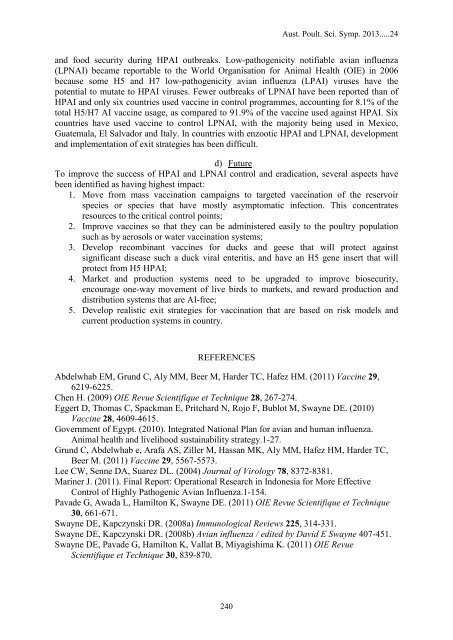APSS 2013 Proceedings - The University of Sydney
APSS 2013 Proceedings - The University of Sydney
APSS 2013 Proceedings - The University of Sydney
You also want an ePaper? Increase the reach of your titles
YUMPU automatically turns print PDFs into web optimized ePapers that Google loves.
Aust. Poult. Sci. Symp. <strong>2013</strong>.....24<br />
and food security during HPAI outbreaks. Low-pathogenicity notifiable avian influenza<br />
(LPNAI) became reportable to the World Organisation for Animal Health (OIE) in 2006<br />
because some H5 and H7 low-pathogenicity avian influenza (LPAI) viruses have the<br />
potential to mutate to HPAI viruses. Fewer outbreaks <strong>of</strong> LPNAI have been reported than <strong>of</strong><br />
HPAI and only six countries used vaccine in control programmes, accounting for 8.1% <strong>of</strong> the<br />
total H5/H7 AI vaccine usage, as compared to 91.9% <strong>of</strong> the vaccine used against HPAI. Six<br />
countries have used vaccine to control LPNAI, with the majority being used in Mexico,<br />
Guatemala, El Salvador and Italy. In countries with enzootic HPAI and LPNAI, development<br />
and implementation <strong>of</strong> exit strategies has been difficult.<br />
d) Future<br />
To improve the success <strong>of</strong> HPAI and LPNAI control and eradication, several aspects have<br />
been identified as having highest impact:<br />
1. Move from mass vaccination campaigns to targeted vaccination <strong>of</strong> the reservoir<br />
species or species that have mostly asymptomatic infection. This concentrates<br />
resources to the critical control points;<br />
2. Improve vaccines so that they can be administered easily to the poultry population<br />
such as by aerosols or water vaccination systems;<br />
3. Develop recombinant vaccines for ducks and geese that will protect against<br />
significant disease such a duck viral enteritis, and have an H5 gene insert that will<br />
protect from H5 HPAI;<br />
4. Market and production systems need to be upgraded to improve biosecurity,<br />
encourage one-way movement <strong>of</strong> live birds to markets, and reward production and<br />
distribution systems that are AI-free;<br />
5. Develop realistic exit strategies for vaccination that are based on risk models and<br />
current production systems in country.<br />
REFERENCES<br />
Abdelwhab EM, Grund C, Aly MM, Beer M, Harder TC, Hafez HM. (2011) Vaccine 29,<br />
6219-6225.<br />
Chen H. (2009) OIE Revue Scientifique et Technique 28, 267-274.<br />
Eggert D, Thomas C, Spackman E, Pritchard N, Rojo F, Bublot M, Swayne DE. (2010)<br />
Vaccine 28, 4609-4615.<br />
Government <strong>of</strong> Egypt. (2010). Integrated National Plan for avian and human influenza.<br />
Animal health and livelihood sustainability strategy.1-27.<br />
Grund C, Abdelwhab e, Arafa AS, Ziller M, Hassan MK, Aly MM, Hafez HM, Harder TC,<br />
Beer M. (2011) Vaccine 29, 5567-5573.<br />
Lee CW, Senne DA, Suarez DL. (2004) Journal <strong>of</strong> Virology 78, 8372-8381.<br />
Mariner J. (2011). Final Report: Operational Research in Indonesia for More Effective<br />
Control <strong>of</strong> Highly Pathogenic Avian Influenza.1-154.<br />
Pavade G, Awada L, Hamilton K, Swayne DE. (2011) OIE Revue Scientifique et Technique<br />
30, 661-671.<br />
Swayne DE, Kapczynski DR. (2008a) Immunological Reviews 225, 314-331.<br />
Swayne DE, Kapczynski DR. (2008b) Avian influenza / edited by David E Swayne 407-451.<br />
Swayne DE, Pavade G, Hamilton K, Vallat B, Miyagishima K. (2011) OIE Revue<br />
Scientifique et Technique 30, 839-870.<br />
240
















